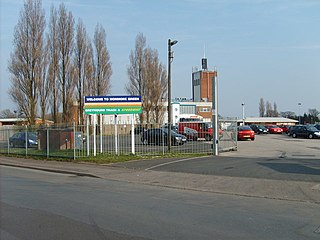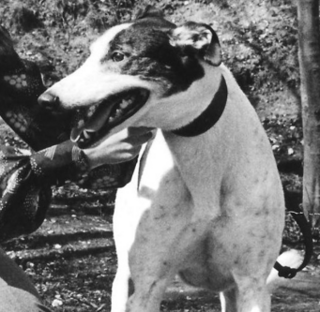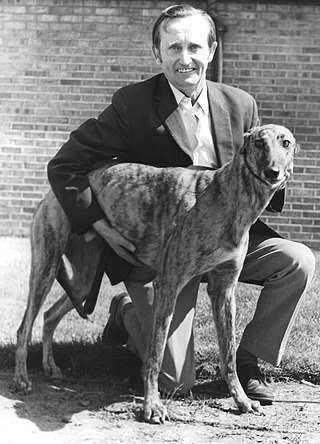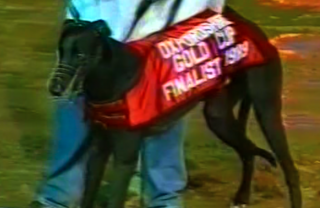 The Stadium in January 1979 | |
 | |
| Location | Hackney, London |
|---|---|
| Opened | 1932 |
| Closed | 1997 |
Hackney Wick Stadium was a greyhound racing and speedway stadium located at Waterden Road in Hackney Wick, London, England.
 The Stadium in January 1979 | |
 | |
| Location | Hackney, London |
|---|---|
| Opened | 1932 |
| Closed | 1997 |
Hackney Wick Stadium was a greyhound racing and speedway stadium located at Waterden Road in Hackney Wick, London, England.
The site chosen for the stadium was on land known as Hackney Marshes west of the River Lea and on the west side of the Waterden Road. [1] The stadium was constructed from September 1931 until 1932 and cost £70,000 to build and after completion £18,000 in wages had been paid to the builders. [2]
Hackney opened On Friday 8 April 1932 under the affiliation of the British Greyhound Tracks Control Society (BGTCS) the rival to the larger National Greyhound Racing Club. Thirteen thousand people attended the first night and witnessed Marjorie Graves, MP for South Hackney officially open the track. The capacity of the track was put between 30,000 and 50,000 and a totalisator had been installed for the first night. A greyhound called Bullseye became the first ever winner at the track. Although the meeting was advertised as the first official meeting there had been a dress rehearsal two days previously on Wednesday 6 April which attracted 12,000 people. [2]
The company responsible for the project was Hackney Wick Stadium Ltd headed by Managing Director Arthur Gilbert and Racing Manager Fred Whitehead with William Chandler also holding shares in the new company, Chandler would in due course buy the Crooked Billet independent track and turn it into Walthamstow Stadium one year later. [3]
After World War II Hackney Wick and Hendon Greyhound Stadium merged to become the Hackney and Hendon Greyhounds Ltd company. The resident kennels featured six ranges with each able to house up to fifty greyhounds, paddocks sat next to each range with cooking facilities and a veterinary surgeon on site. The kennel fees were 17s 6d for each greyhound. [3]
In 1948, Stanley Pay became the Racing Manager after Fred Whitehead was promoted to Director of Racing for both Hackney and Hendon. [4] Pay was later replaced by Hendon Racing Manager D G Lewis before Michael Marksbecame Racing Manager for three decades until the day the stadium closed. The stadium offered eight buffet and licensed bars during racing held on Thursday and Saturday nights at 7.45pm. The circuit had a circumference of 472 yards and the greyhounds raced behind an 'Outside Sumner' hare system. Trainers in the 1960s included Annetts, Reg Bosley, Brown, Colebrooke, Cox, Paddy Gordon, Hedley and Lionel Maxen. [5]
In the 1970s Mr G.Crookbank the track's chief electrician had invented photoelectric timing gear that would revolutionise the sport. Hand timing would become a thing of the past after Crookbank came up with the idea that a greyhound's race time could be recorded electronically. The invention known as 'Automatic Ray Timing' would remain as the timing method until the advent of modern computer timing. The Hackney sales became a major feature of business throughout the year, these sales became a prominent way for buying and selling greyhounds in London. [6]
In 1969 Park Royal Stadium and New Cross Stadium both closed resulting in the Bookmakers Afternoon Greyhound Service (BAGS) being switched to Hendon and Hackney, the racing image of Hackney would change forever as it became the number one BAGS track. Afternoon meetings were introduced and eventually there would be no evening meetings at the track with the Saturday matinee BAGS replacing the Saturday night. [6]
In 1970 businessman George Walker, brother of boxing champion Billy Walker arranged a reverse takeover of Hackney and Hendon Greyhounds Stadium Ltd. This meant his private company bought a public company and the new merger resulted in a new company called Brent Walker. This resulted in the end for the Hendon Greyhound Stadium because it was sold to make way for the UK's first stand-alone shopping centre on the site that would soon be known as the Brent Cross shopping centre. [6]
It was not until the closure of sister track Hendon that Hackney Wick hosted a competition of note. The Guineas long associated with Park Royal had switched to Hendon in 1969 which in turn now found its way to Hackney. Three years later 'The Lead' was introduced and would also become a valuable addition to the calendar. [6] In 1976 local hound Westmead Champ trained by Pam Heasman reached the final of the English Greyhound Derby and was voted Greyhound of the Year. [7]
Hackney fell out with the NGRC in 1987 when the governing body announced that they would charge £300 to a track staging a BAGS meeting covered by Satellite Information Services (S.I.S) plus ten per cent of the tracks BAGS fees. Hackney refused and Ladbrokes took legal advice over the situation but all BAGS tracks would eventually pay a fee to the NGRC. Another race called the Lincoln was hosted by Hackney from 1986 and in 1988 Minnies Siren trained by Terry Duggan won the BBC Television Trophy. Brent Walker bought William Hill/Mecca from Grand Metropolitan in 1989 and one year later leading trainer John 'Ginger' McGee Sr. joined the track. [8]
During 1991 it transpired that Brent Walker had amassed debts of £1.2 billion, George Walker was removed from the board and the banker took control of the company's assets. With the bank controlling matters there were numerous rumours about the future of the track. By 1994 the stadium had been acquired by a company called London Stadium Hackney Ltd who were in turn owned by Fleetfoot Racing formed in 1992 by ex-Lloyds broker and racing journalist Robert Parker. Work began on an ambitious project including a £12 million restaurant, leading trainers were recruited and the stadium was rebranded 'The London Stadium'. [9]
At the end of 1994 Robert Parker left the company as its director to be replaced by Stephen Rea. Beset with construction problems and internal disagreements the original £14 million scheme to develop the neglected stadium had run into serious problems. Extra cash was raised by rights issues with companies including Rothschild, Henderson Venture Managers and Samuel Montagu. In October 1995 the new stadium was finally ready offering first-class facilities and significantly high prize money. However, on the reopening night and despite a capacity crowd the stadium went into receivership the same evening. Investigations began and banker, Stephen Welton, was pursued by LWT reporter Trevor Phillips and questioned for the Board's failure to conduct due diligence on a prospective buyer who turned out to be an undischarged bankrupt. [10] Parker appeared on Roger Cook's ITV's television program The Cook Report and allegations were also made against Stephen Rea. Fleetfoot Racing Ltd had lasted just three years, with the stadium closing on 4 January 1997. [11] [12]
The stadium was left derelict for several years until it was bought by the London Development Agency and demolished in 2003. The site was the location of the London Olympics Media Centre, the main media and broadcasting centre for the 2012 Summer Olympics and the 2012 Summer Paralympics.
Speedway opened in 1935 at Hackney Wick Stadium and operated until 1996. [13] The team raced under various names, known as Hackney Wick Wolves, Hackney Hawks, Hackney Kestrels and London Lions. [14] The speedway scenes from the 1933 film Britannia of Billingsgate were shot at the stadium. [15]
The track introduced the Lead sponsored by William Hill in 1975; at the same time they switched the 1,000 Guineas to a longer distance of 484 metres. [16] [17] [18] [19]
| Year | Winner | Breeding | Trainer | Time | SP |
|---|---|---|---|---|---|
| 1975 | Baffling Bart [20] | The Grand Silver - Mosaduva | Paddy Milligan (Private) | 31.79 | 4/6f |
| 1976 | Bold Flight | Bold Invader – Fantastic Flight | P Hawke (Private) | 32.27 | 10/11f |
| 1977 | Gaily Noble | Monalee Champion – Noble Lynn | John Coleman (Wembley) | 31.81 | 3/1 |
| 1978 | Special Addition | Special – Brownsgrove Lass | Draper (Sheffield) | 31.82 | 8/1 |
| 1979 | Decoy Duke | Westmead County – Rip Madam | Joe Cobbold Cambridge | 31.55 | 7/1 |
| 1980 | Democracy | Free Speech – Glen Eivers | Pat Mullins Cambridge | 31.74 | 6/4f |
| 1981 | Sugarville Jet | Cairnville Jet – Santas Sugar | John Honeysett (Crayford) | 31.86 | 10/11f |
| 1982 | Master Darby | Sole Aim – Aglish Pilgrim | Jerry Fisher (Reading) | 31.72 | 4/6f |
| 1983 | Legrand | Shamrock Sailor – Well Honestly | George Curtis (Brighton) | 32.12 | 7/2 |
| 1984 | Ballyregan Bob | Ballyheigue Moon – Evening Daisy | George Curtis (Brighton) | 31.07 | 4/7f |
| 1985 | Gabriel Andy | Lindas Champion – Gabriel Penny | Derek Knight (Brighton) | 31.85 | 4/1 |
| 1986 | Copper King | I'm Slippy - Cleona | Ken Reynolds (Monmore) | 31.64 | 15/8f |
| 1987 | Killouragh Chris | Moreen Rocket – Moree Honey | Pete Beaumont (Sheffield) | 32.30 | 15/8 |
| 1988 | Bankers Benefit | Easy and Slow – Society Girl | Adam Jackson (Wembley) | 31.88 | 7/2 |
| 1989 | Labana Matthew | Matthews World – Labana Queen | Geoff De Mulder (Norton Canes) | 31.86 | 1/1f |
| 1990 | Shanavulin Bingo | Michigan Man – Shanavulin Flash | Ernie Gaskin Sr. (Private) | 31.58 | 8/11f |
| 1991 | Lets All Boogie | Carters Lad – Princess Alucard | John Coleman (Walthamstow) | 32.08 | 9/4 |
| 1992 | Daleys Denis | Daleys Gold – Lisnakill Flyer | Tom Pett (Canterbury) | 31.67 | 10/11f |
1975-1992 (523 metres)
| Distance (yards) | Greyhound | Time | Date |
|---|---|---|---|
| 300 | Montforte Louis | 16.45 | 30 July 1965 |
| 500 | Don Gipsey | 27.93 | 24 April 1948 |
| 525 | Fitzs Bell | 29.30 | 27 June 1963 |
| 525 | Kybo Venture | 29.52 | 1973 |
| 550 | Parish Model | 31.16 | 26 May 1947 |
| 550 | Narrogar Ann | 31.09 | 1949 |
| 550 | Prince of Speed | 30.61 | 21 July 1960 |
| 565 | Kybo Venture | 31.60 | 1973 |
| 570 | Willing Billy | 31.98 | 1970 |
| 700 | Spotted Nice | 40.20 | 1970 |
| 725 | Surprising Paddle | 41.36 | 20 July 1963 |
| 800 | Chantilly Lace | 45.86 | 14 April 1960 |
| 500 H | Dollys Prince | 28.55 | 1963 |
| 550 H | Fairyfield Surprise | 31.50 | 20 June 1963 |
| Distance (metres) | Greyhound | Time | Date | Notes |
|---|---|---|---|---|
| 247 | Ballygroman Jim | 15.17 | 1986 | |
| 260 | Fast Copper | 15.52 | 20 April 1994 | |
| 304 | Clear Reason | 18.02 | 1 March 1975 | |
| 400 | Danesfort Slippy | 25.01 | 26 March 1994 | |
| 440 | Jurassic Park | 26.70 | 23 September 1994 | |
| 484 | London Spec | 29.02 | 27 March 1976 | |
| 484 | Lassa Java | 28.86 | 24 March 1994 | |
| 484 | Staplers Jo | 28.56 | 1995 | Guineas first round |
| 523 | Drynham Star | 31.48 | 22 February 1975 | |
| 523 | Wired To Moon | 31.48 | 10 December 1977 | |
| 523 | Sound Wave | 31.48 | 12 January 1980 | |
| 523 | Ballyregan Bob | 31.07 | 11 December 1984 | |
| 640 | Coolmona Road | 39.95 | 22 August 1994 | |
| 683 | Millies Corner | 42.73 | 10 November 1983 | |
| 683 | Blue Shirt | 42.68 | 11 December 1984 | |
| 683 | Ballyregan Bob | 42.24 | 16 November 1985 | |
| 685 | Coolmona Road | 42.95 | 15 July 1994 | |
| 669 | Mondays Style | 41.80 | 24 October 1974 | |
| 740 | Dublin Daisy | 46.17 | 1 January 1976 | |
| 740 | Tally Ho Sabrina | 45.88 | 7 April 1980 | |
| 740 | Swift Duchess | 45.83 | 21 May 1986 | |
| 825 | Winetavern Celt | 53.78 | 12 December 1994 | |
| 909 | Smart Decision | 58.88 | 7 April 1994 | |
| 920 | Wild Surprise | 60.29 | 7 March 1985 | |
| 920 | My Tootsie | 59.21 | 1986 | |
| 400 H | Fancy Major | 25.44 | 25 November 1994 | |
| 484 H | Westpark Clover | 30.28 | 6 March 1984 | |
| 485 H | Kildare Slippy | 30.10 | 20 July 1991 | |
| 485 H | Gis A Smile | 29.72 | 7 February 1994 | |
| 523 H | Breakaway Slave | 32.87 | 10 April 1982 | |
| 640 H | Freewheel Kylo | 42.95 | 27 December 1993 |

Wimbledon Stadium, also known as Wimbledon Greyhound Stadium, was a greyhound racing track located in Wimbledon in southwest London, England.
George Alfred Walker was a British businessman and founder of Brent Walker.

Monmore Green Stadium is a greyhound racing and former motorcycle speedway stadium located in Wolverhampton. The stadium has private suites, a restaurant and a number of bars. The venue is owned and operated by the Ladbrokes Coral group.

Park Royal Greyhound Stadium was a greyhound racing stadium in London used from 1931 until 1969. It is not to be confused with the Park Royal Ground built in 1907 by the Great Western Railway and used by Queens Park Rangers F.C. from 1907 to 1915.
Crayford & Bexleyheath Stadium was a greyhound racing and motorcycle speedway stadium in the London Borough of Bexley.
Stanley Greyhound Stadium (Liverpool) was a greyhound racing track in east Liverpool, England. It is not to be confused with Stanley Greyhound Stadium in County Durham also known as Murray Park.
Hendon Greyhound Stadium was a greyhound racing stadium in Hendon, London.
The 1936 UK & Ireland Greyhound Racing Year was the 11th year of greyhound racing in the United Kingdom and Ireland.
The 1937 UK & Ireland Greyhound Racing Year was the 12th year of greyhound racing in the United Kingdom and Ireland.
The 1967 UK & Ireland Greyhound Racing Year was the 41st year of greyhound racing in the United Kingdom and Ireland.
The 1969 UK & Ireland Greyhound Racing Year was the 43rd year of greyhound racing in the United Kingdom and Ireland.

The 1970 UK & Ireland Greyhound Racing Year was the 44th year of greyhound racing in the United Kingdom and Ireland.

The 1971 UK & Ireland Greyhound Racing Year was the 45th year of greyhound racing in the United Kingdom and Ireland.

The 1972 UK & Ireland Greyhound Racing Year was the 46th year of greyhound racing in the United Kingdom and Ireland.

The 1976 UK & Ireland Greyhound Racing Year was the 50th year of greyhound racing in the United Kingdom and Ireland.
The 1980 UK & Ireland Greyhound Racing Year was the 54th year of greyhound racing in the United Kingdom and Ireland.

The 1989 UK & Ireland Greyhound Racing Year was the 63rd year of greyhound racing in the United Kingdom and Ireland.
The 1994 UK & Ireland Greyhound Racing Year was the 68th year of greyhound racing in the United Kingdom and Ireland.
The 1995 UK & Ireland Greyhound Racing Year was the 69th year of greyhound racing in the United Kingdom and Ireland.

The Guineas originally called the One Thousand Guineas was a greyhound racing competition held annually. It was inaugurated in 1939 at Park Royal Stadium over 400 yards.